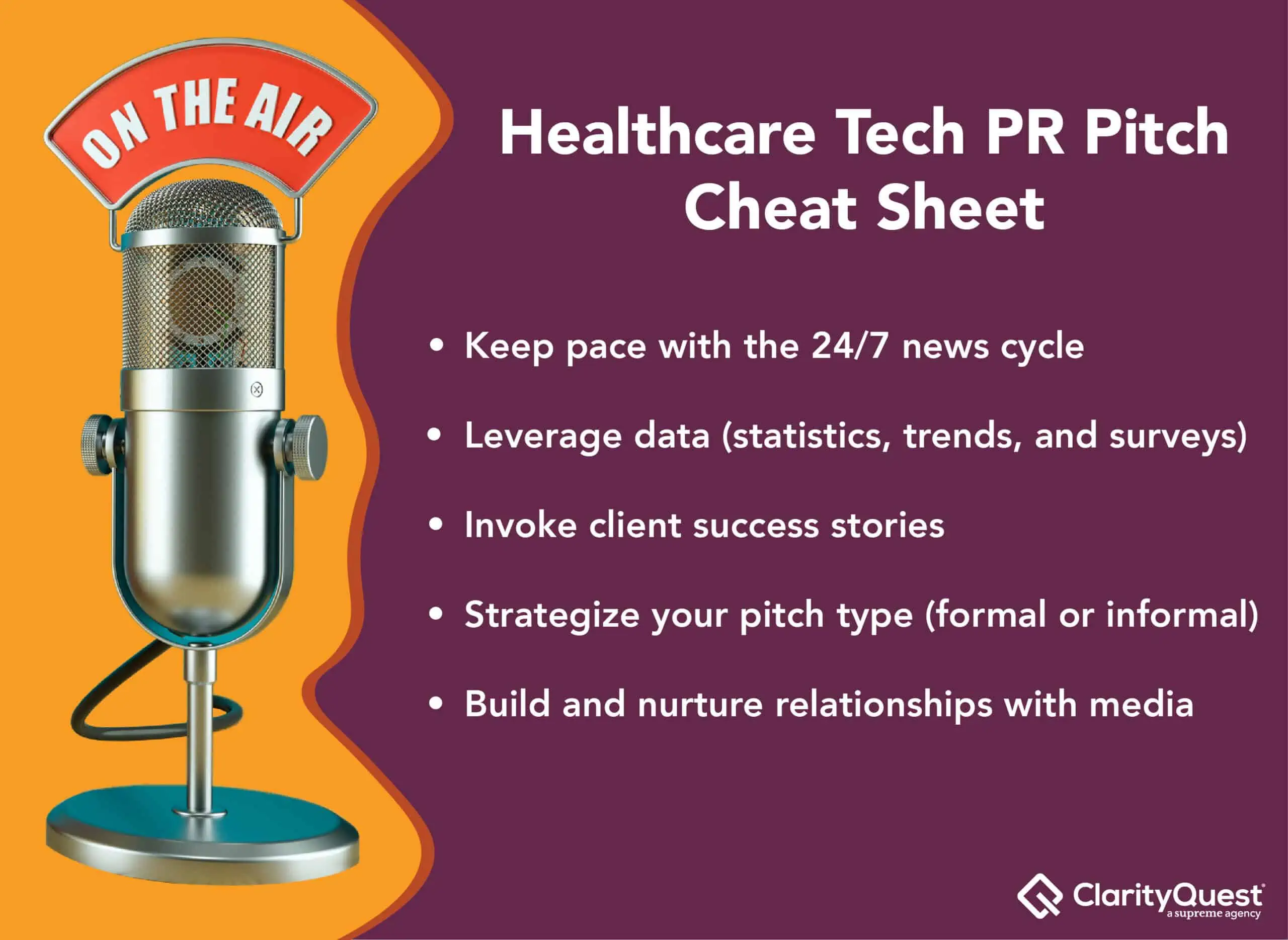Healthcare technology media relations strategies are not one-size-fits-all, even within such a narrow niche. Health tech is a dynamic field that demands a unique blend of experience, creativity, knowledge, and timing. In a world where information flows ceaselessly, reporters find their inboxes inundated daily with hundreds of pitches, each vying for their attention and time.
As a publicist, success hinges on a delicate dance: understanding your clients’ endeavors, discerning the elements that make a story captivating, and pinpointing the ideal reporter to work with in order to craft and convey your narrative.
In this complex orchestration of media relations, every note must harmonize to create a symphony of compelling stories that resonate with the proper audience.
Navigating the 24/7 news cycle: staying in the know
As you develop your healthcare technology media relations strategies, keeping pace with the 24/7 news cycle is not just an advantage—it’s a necessity. This is true of most industries and even more so in healthcare technology public relations.
Journalists are always on the hunt for the next big scoop. As publicists, we are here to be their guiding star. This means maintaining an unwavering awareness of current events, industry trends, current coverage, and emerging narratives.
In the blink of an eye, a newsworthy opportunity can emerge. Being nimble and prepared to seize it is the hallmark of a seasoned media relations practitioner. In this fast-paced landscape, timing is everything.
Crafting captivating stories: elements that resonate
At the heart of compelling media pitches lies a set of key elements that resonate with reporters and readers. Understanding these elements is pivotal to success in media relations.
Data: the power of numbers
Data-driven narratives hold a unique allure. Statistics, trends, and surveys provide not just information but also authority. They bolster your story with evidence, transforming it from an opinion into a credible insight.
For reporters, data can be a goldmine. For readers, it adds depth and substance to the story. Whether it’s unveiling the latest industry statistics or conducting a groundbreaking survey, data-driven pitches have the power to captivate and convince.
Timeliness: the urgency of now
In the world of media, relevance is king. A story that’s pertinent today might lose its sparkle tomorrow.
Timeliness is the secret sauce that can transform a pitch from ordinary to extraordinary. Pay attention to current events, trending topics, and the issues that matter right now.
When you can align your pitch with the ongoing conversation, you increase your chances of media coverage and contribute to a richer, more informed public discourse.
Client stories: real-life narratives
Behind every business is a story waiting to be told.
Client success stories humanize your pitch. They offer a glimpse into the impact your client has had on individuals and organizations. These stories can evoke emotions, making your pitch more engaging and relatable.
Whether it’s a transformative journey, a heartwarming anecdote, or a tale of resilience, client stories have the power to resonate deeply with both reporters and their audiences. Client stories and case studies take your client’s expertise out of the abstract and into the real world.
By showcasing how your client’s solutions have solved real problems or created tangible benefits, you offer a relatable dimension to your story. Case studies provide evidence that your client’s solutions made a difference, making them an invaluable addition to your pitch toolkit.
The art of the pitch: tailoring your approach
As a publicist, your pitch is your voice in the crowded media landscape.
Pitching has come a long way since the days of mailing press releases and sending faxes to reporters. Today, most pitching takes place over email and, like any other form of content, is unique to the writer. Some publicists lean toward the formal, traditional approach, while others adopt a more casual, conversational tone.
The key is to adapt your style to match the nature of the story and the preferences of the reporter you’re addressing.
Formal pitch: precision and tradition
A formal pitch is characterized by its precision and adherence to traditional PR norms. It’s meticulous, well-researched, and carefully structured.
This approach is ideal when dealing with publications that demand a high level of professionalism or when pitching complex healthcare research.
Casual pitch: approachable and conversational
Conversely, a casual pitch takes a more relaxed, conversational approach. It can be highly effective when dealing with reporters who prefer a friendly, approachable style or when pitching human-interest stories.
In a casual pitch, start with a friendly greeting. Introduce the story in a more relaxed manner. Maintain a conversational tone throughout. This approach can create a sense of authenticity and ease, fostering a more personal connection with the reporter.
Building bridges: the power of relationships
In the intricate dance of media relations, relationships are the threads that weave the tapestry of trust.
Building and nurturing connections with editors, reporters, and influencers is instrumental in gaining media coverage. It’s not a one-time endeavor but an ongoing commitment to understanding each journalist’s unique preferences, interests, and deadlines.
Building rapport takes time, patience, and consistent effort. It’s about being a valuable resource, offering insights, and respecting their time and expertise.
The ultimate quest: telling captivating stories
Beyond all the tactics and techniques, one fundamental truth underpins all healthcare technology media relations strategies: reporters are storytellers. They are seekers of stories that engage, inform, and resonate.
Our ultimate quest as publicists is to offer stories that capture reporters’ curiosity and resonate deeply with readers. Whether your pitch style is formal or casual, data-driven or anecdotal, it all boils down to one central tenet: media relations is the art of storytelling, and captivating stories are what drive the industry forward.
Each pitch is a note in the symphony of news, a chance to contribute to the ongoing narrative of our world, and a reminder that, in the end, it’s the stories that endure.



